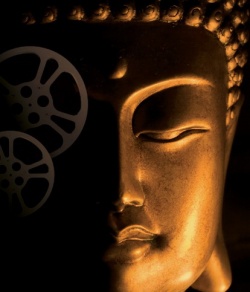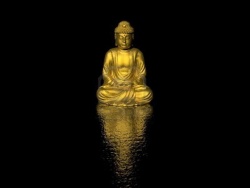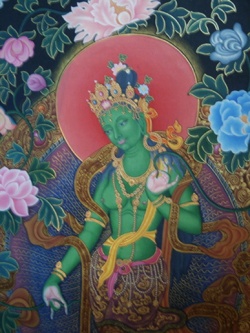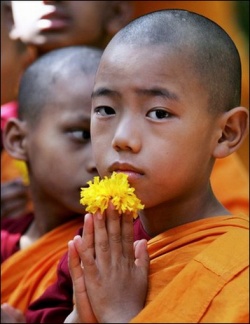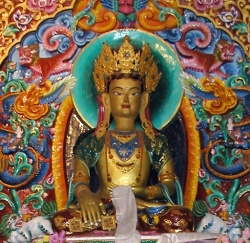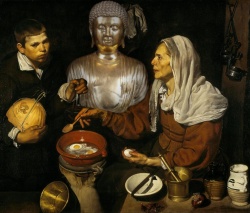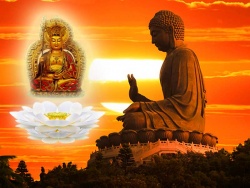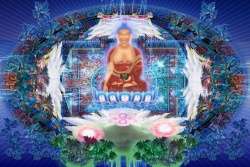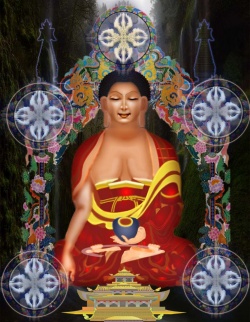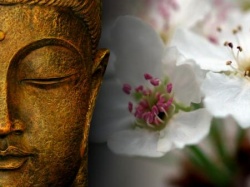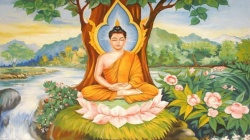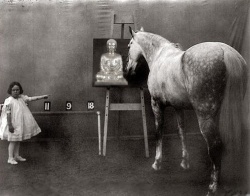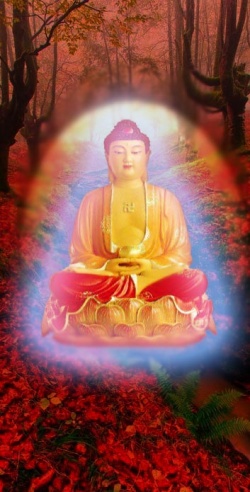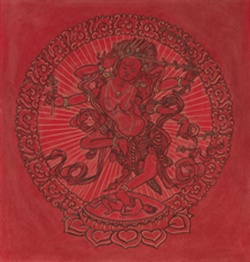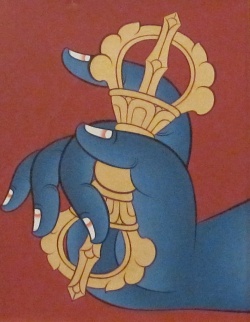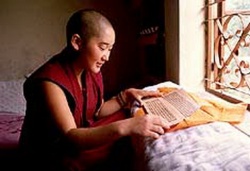Difference between revisions of "The Main Features of Tantra"
(Created page with " The word tantra (rgyud) means an everlasting {{Wiki|continuum}}. There are three levels of such continuums: The basis everlasting {{Wiki|continuum}} – the {...") |
|||
| (One intermediate revision by the same user not shown) | |||
| Line 1: | Line 1: | ||
| + | <nomobile>{{DisplayImages|2746|122|1557|2683|711|1792|3125|2101|3791|4361|4393|4238|4396|1162|4066|1285|1804|2073|4514|3970|2459|3743|1474|3611|2936}}</nomobile> | ||
| + | <poem> | ||
| + | The [[word]] [[tantra]] (99rgyud00) means an everlasting {{Wiki|continuum}}. There are three levels of such continuums: | ||
| + | The basis everlasting {{Wiki|continuum}} – the {{Wiki|individual}} [[mental continuum]] ([[mind-stream]]) of each limited being ([[sentient being]]), with all its [[Buddha-nature]] factors ([[khams de-bzhin snying-po]]) that enable [[enlightenment]] | ||
| − | The [[ | + | The pathway everlasting {{Wiki|continuum}} – the continuity of [[Mahayana]] practices with [[Buddha-figures]] ([[yi-dam]], [[tantric deities]]), which can be sustained without end since [[Buddha-figures]] never grow tired or old, and never [[die]] |
| − | |||
| − | |||
The resultant everlasting {{Wiki|continuum}} – the unending continuity of the [[enlightening]] corpuses ([[bodies]]) of a [[Buddha]]. | The resultant everlasting {{Wiki|continuum}} – the unending continuity of the [[enlightening]] corpuses ([[bodies]]) of a [[Buddha]]. | ||
Practice of a pathway {{Wiki|continuum}} purifies fleeting stains from a person's basis {{Wiki|continuum}} so that it transforms into a resultant {{Wiki|continuum}}. The texts that discuss these topics are also [[tantras]]. | Practice of a pathway {{Wiki|continuum}} purifies fleeting stains from a person's basis {{Wiki|continuum}} so that it transforms into a resultant {{Wiki|continuum}}. The texts that discuss these topics are also [[tantras]]. | ||
| − | The Classes of | + | |
| + | |||
| + | The [[Classes of Tantra]] | ||
| + | |||
The three [[Tibetan Buddhist]] [[lineages]] of the [[New Translation]] Period – [[Sakya]], [[Kagyu]], and [[Gelug]] – divide [[tantra]] into four classes: | The three [[Tibetan Buddhist]] [[lineages]] of the [[New Translation]] Period – [[Sakya]], [[Kagyu]], and [[Gelug]] – divide [[tantra]] into four classes: | ||
| − | [[Kriya]] ([[ritual | + | [[Kriya]] ([[ritual Buddha-figure practice]]) – {{Wiki|emphasizing}} external [[ritual practices]] such as ablution, [[diet]], and [[fasting]] |
| − | [[Charya]] ( | + | [[Charya]] ([[Wiki|behavioral Buddha-figure practice]]) – equally {{Wiki|emphasizing}} external {{Wiki|behavior}} and internal [[methods]] |
| − | [[Yoga]] ( | + | [[Yoga]] ([[integrated Buddha-figure practice]]) – {{Wiki|emphasizing}} internal [[methods]] of [[yoga]] |
| − | [[Anuttarayoga]] (peerlessly integrated | + | [[Anuttarayoga]] ([[peerlessly integrated Buddha-figure practice]]) – {{Wiki|emphasizing}} special, more advanced [[methods]] of internal practice. |
| + | |||
| + | |||
| + | The [[Nyingma lineage]], from the [[Old Translation Period]], transmits [[six classes of tantra]], the same first three and, [[corresponding]] to progressively more advanced stages of [[anuttarayoga]]: | ||
| + | |||
| + | |||
| + | 4. [[Mahayoga]] ([[greatly integrated Buddha-figure practice]]) – {{Wiki|emphasizing}} [[visualization]] | ||
| − | + | 5. [[Anuyoga]] ([[subsequent integrated Buddha-figure practice]]) – {{Wiki|emphasizing}} work with the [[subtle energy systems]] | |
| − | + | 6. [[Atiyoga]] ([[supremely integrated Buddha-figure practice]]) or [[dzogchen]] ([[rdzogs-chen]], the [[great completeness]]) {{Wiki|emphasizing}} the subtlest level of [[mental activity]] ([[mind]]). | |
| − | |||
| − | |||
Preliminaries | Preliminaries | ||
| − | All classes of [[tantra]] require achieving a level of [[spiritual]] proficiency with [[preliminary practices]] ([[sngon-'gro]], "[[ngondro]]") as preparation before embarking on their [[paths]]. These include gaining a level of stability in the preliminaries shared in common with [[bodhisattva | + | |
| + | All classes of [[tantra]] require achieving a level of [[spiritual]] proficiency with [[preliminary practices]] ([[sngon-'gro]], "[[ngondro]]") as preparation before embarking on their [[paths]]. These include gaining a level of stability in the preliminaries shared in common with [[bodhisattva sutra practice]] and completing a certain amount of special practices not shared with [[sutra]]. | ||
| + | |||
Shared Preliminaries | Shared Preliminaries | ||
| − | The preliminaries shared in common with [[bodhisattva | + | The preliminaries shared in common with [[bodhisattva sutra practice]] entail gaining the [[four thoughts that turn the mind]] toward the [[Dharma]] ([[blo-ldog rnam-bzhi]]). |
| + | |||
| + | They are [[appreciation]] of: | ||
A [[precious human rebirth]] | A [[precious human rebirth]] | ||
| Line 38: | Line 51: | ||
The disadvantages of uncontrollably recurring [[rebirth]] (Skt. [[samsara]]). | The disadvantages of uncontrollably recurring [[rebirth]] (Skt. [[samsara]]). | ||
| − | All [[tantra]] classes also require a {{Wiki|stable}} background in the other [[bodhisattva | + | |
| + | All [[tantra]] classes also require a {{Wiki|stable}} background in the other [[bodhisattva sutra practices]]. [[Tantra]], in fact, is a method for [[combining]] and simultaneously practicing them all. | ||
| + | |||
| + | The [[sutra]] practices include: | ||
Safe [[direction]] ([[refuge]]) | Safe [[direction]] ([[refuge]]) | ||
| Line 48: | Line 64: | ||
[[Bodhichitta]] (a [[heart]] dedicated to [[enlightenment]] and to helping others) | [[Bodhichitta]] (a [[heart]] dedicated to [[enlightenment]] and to helping others) | ||
The other far-reaching attitudes (Skt. [[paramita]], [[perfections]]) of [[generosity]], [[patience]] and perseverance. | The other far-reaching attitudes (Skt. [[paramita]], [[perfections]]) of [[generosity]], [[patience]] and perseverance. | ||
| + | |||
Unshared Preliminaries | Unshared Preliminaries | ||
| − | To {{Wiki|purify}} internal negative forces ([[sdig-pa]], Skt. [[papa]], negative potentials) and build up positive ones ([[bsod-nams]], Skt. [[punya]], positive potentials, [[merit]]), [[tantra practice]] also requires at least a certain amount of special preliminaries not shared with [[sutra]] practice. Most often, they entail a hundred thousand repetitions of: | + | |
| + | To {{Wiki|purify}} [[internal negative forces]] ([[sdig-pa]], Skt. [[papa]], [[negative potentials]]) and build up positive ones ([[bsod-nams]], Skt. [[punya]], positive potentials, [[merit]]), [[tantra practice]] also requires at least a certain amount of special preliminaries not shared with [[sutra]] practice. Most often, they entail a hundred thousand repetitions of: | ||
| + | |||
[[Prostration]], together with a verse for taking safe [[direction]] and reaffirming [[bodhichitta]] | [[Prostration]], together with a verse for taking safe [[direction]] and reaffirming [[bodhichitta]] | ||
The [[hundred-syllable mantra]] of [[Vajrasattva]] ([[rDo-rje]] [[sems-pa]]), for [[purification]] | The [[hundred-syllable mantra]] of [[Vajrasattva]] ([[rDo-rje]] [[sems-pa]]), for [[purification]] | ||
[[Mandala offerings]], [[symbolic]] of giving everything toward the [[attainment]] of [[enlightenment]] and the [[benefit]] of others | [[Mandala offerings]], [[symbolic]] of giving everything toward the [[attainment]] of [[enlightenment]] and the [[benefit]] of others | ||
| − | |||
| − | [[Mantras]] ([[sngags]]) are [[Sanskrit]] words and {{Wiki|syllables}} repeated, as the {{Wiki|etymology}} of the [[Sanskrit]] term implies, to "{{Wiki|protect}} the [[mind]]" from negativity. A [[mandala]] (dkyil-'khor) is a [[symbol]] of a [[universe]]. A hundred thousand or more repetitions may also be required of several other unshared [[preliminary practices]]. The [[Gelug tradition]], for example, counts [[prostration]] and the verse for safe [[direction]] and [[bodhichitta]] as two separate preliminaries, and normally adds four more, making nine preliminaries in total: | + | A verse or [[mantra]] of [[guru-yoga]] ([[bla-ma'i rnal-'byor]], "[[lamay neljor]]"), for integrating our [[bodies]], {{Wiki|speech}}, and [[minds]] with those of the [[spiritual masters]], who are [[Buddhas]] for us. |
| + | |||
| + | [[Mantras]] ([[sngags]]) are [[Sanskrit]] words and {{Wiki|syllables}} repeated, as the {{Wiki|etymology}} of the [[Sanskrit]] term implies, to "{{Wiki|protect}} the [[mind]]" from negativity. A [[mandala]] ([[dkyil-'khor]]) is a [[symbol]] of a [[universe]]. | ||
| + | |||
| + | A hundred thousand or more repetitions may also be required of several other unshared [[preliminary practices]]. The [[Gelug tradition]], for example, counts [[prostration]] and the verse for safe [[direction]] and [[bodhichitta]] as two separate preliminaries, and normally adds four more, making nine preliminaries in total: | ||
| − | The [[mantra]] of [[Samayavajra]] (Dam-tshig | + | The [[mantra]] of [[Samayavajra]] ([[Dam-tshig rdo-rje]]), for [[purification]] of our close bonds ([[dam-tshig]], Skt. [[samaya]]) with our [[spiritual masters]] |
| − | [[Offerings]] of sesame [[seeds]] to | + | [[Offerings]] of sesame [[seeds]] to [[Bhuji Vajradaka]] ([[Za-byed rdo-rje mkha-'gro]]), made into a [[fire]] to burn off negative forces from our [[mental]] continuums |
| − | [[Water | + | [[Water bowl offerings]] |
Making clay votive tablets ([[tsa-tsa]]) with the [[impression]] on them of a [[Buddha-figure]] or [[lineage master]]. | Making clay votive tablets ([[tsa-tsa]]) with the [[impression]] on them of a [[Buddha-figure]] or [[lineage master]]. | ||
| − | All [[Tibetan traditions]] require the basic [[sutra]] preliminaries, such as safe [[direction]] and what the [[Gelug tradition]] calls "the [[three principal pathway minds]]" (lam-gtso rnam-gsum): [[renunciation]], [[bodhichitta]], and an accurate [[understanding]] of [[voidness]]. We need to be able to generate these pathway [[minds]] at least {{Wiki|artificially}} (bcos-ma), which means working ourselves up to an accurate {{Wiki|conceptual}} [[state]] of them by relying on a valid line of {{Wiki|reasoning}}. A [[pathway mind]] does not need to be [[nonconceptual]] for it to be {{Wiki|sincere}} and for us to [[feel]] it on an [[emotional]] level. | + | All [[Tibetan traditions]] require the basic [[sutra]] preliminaries, such as safe [[direction]] and what the [[Gelug tradition]] calls "the [[three principal pathway minds]]" ([[lam-gtso rnam-gsum]]): [[renunciation]], [[bodhichitta]], and an accurate [[understanding]] of [[voidness]]. We need to be able to generate these pathway [[minds]] at least {{Wiki|artificially}} ([[bcos-ma]]), which means working ourselves up to an accurate {{Wiki|conceptual}} [[state]] of them by relying on a valid line of {{Wiki|reasoning}}. A [[pathway mind]] does not need to be [[nonconceptual]] for it to be {{Wiki|sincere}} and for us to [[feel]] it on an [[emotional]] level. |
Before receiving an [[initiation]], [[Gelug]] recommends having at least begun the practice of a hundred thousand repetitions of each of the special preliminaries, with the provision that we continue them afterwards. The non-Gelug [[traditions]] recommend completing at least one set of a hundred thousand repetitions of each special preliminary before receiving an [[initiation]]. All [[traditions]] {{Wiki|emphasize}}, however, the continuing practice of the special preliminaries as an ongoing part of daily practice. | Before receiving an [[initiation]], [[Gelug]] recommends having at least begun the practice of a hundred thousand repetitions of each of the special preliminaries, with the provision that we continue them afterwards. The non-Gelug [[traditions]] recommend completing at least one set of a hundred thousand repetitions of each special preliminary before receiving an [[initiation]]. All [[traditions]] {{Wiki|emphasize}}, however, the continuing practice of the special preliminaries as an ongoing part of daily practice. | ||
| − | |||
| − | |||
| − | [[Empowerment]] ([[dbang]], "wang," [[initiation]]) | + | |
| − | Subsequent permission ([[rjes-snang]], "[[jenang]]," permission) | + | [[Three Types of Initiatory Ceremony]] |
| + | |||
| + | |||
| + | Upon completion of a certain amount of [[preliminary practices]], actual engagement in [[tantric practice]] requires an {{Wiki|initiatory}} {{Wiki|ceremony}}. | ||
| + | |||
| + | There are three types: | ||
| + | |||
| + | [[Empowerment]] ([[dbang]], "[[wang]]," [[initiation]]) | ||
| + | [[Subsequent permission]] ([[rjes-snang]], "[[jenang]]," permission) | ||
[[Mantra-gathering]] ([[sngags-btus]]). | [[Mantra-gathering]] ([[sngags-btus]]). | ||
| + | |||
[[Empowerment]] | [[Empowerment]] | ||
| − | [[Visualization]] of ourselves as [[Buddha-figures]] requires receiving an [[empowerment]] beforehand. An [[empowerment]] enables [[success]] in our practice by: | + | |
| + | [[Visualization]] of ourselves as [[Buddha-figures]] requires receiving an [[empowerment]] beforehand. | ||
| + | |||
| + | An [[empowerment]] enables [[success]] in our practice by: | ||
Establishing a close bond with a [[tantric master]] as a living source of inspiration ([[byin-rlabs]], [[blessings]]) | Establishing a close bond with a [[tantric master]] as a living source of inspiration ([[byin-rlabs]], [[blessings]]) | ||
| Line 86: | Line 118: | ||
Activating the factors of our [[Buddha-natures]] | Activating the factors of our [[Buddha-natures]] | ||
Enhancing those factors by leaving a legacy ([[sa-bon]], planting "[[seeds]]") on our [[mental]] continuums from the [[conscious]] [[experience]] of specific [[states of mind]] and [[insight]] during the [[ritual]] – such as [[blissful awareness of voidness]] in [[Gelug]] [[anuttarayoga]], or of our [[Buddha-natures]] in non-Gelug. | Enhancing those factors by leaving a legacy ([[sa-bon]], planting "[[seeds]]") on our [[mental]] continuums from the [[conscious]] [[experience]] of specific [[states of mind]] and [[insight]] during the [[ritual]] – such as [[blissful awareness of voidness]] in [[Gelug]] [[anuttarayoga]], or of our [[Buddha-natures]] in non-Gelug. | ||
| + | |||
We do not actually receive an [[empowerment]] unless we: | We do not actually receive an [[empowerment]] unless we: | ||
| + | |||
Have [[respect]] for and [[confidence]] in the [[tantric]] method, optimally by having a good [[understanding]] of it | Have [[respect]] for and [[confidence]] in the [[tantric]] method, optimally by having a good [[understanding]] of it | ||
| Line 95: | Line 129: | ||
Actively participate in the [[visualization]] process, as best as we can | Actively participate in the [[visualization]] process, as best as we can | ||
Gain [[conscious]] [[experiences]] of the specific [[mental states]] or [[insights]] described by our [[tantric masters]] during the {{Wiki|ceremony}}, to whatever level we are capable at the time. | Gain [[conscious]] [[experiences]] of the specific [[mental states]] or [[insights]] described by our [[tantric masters]] during the {{Wiki|ceremony}}, to whatever level we are capable at the time. | ||
| + | |||
| + | |||
[[Sadhanas]], [[Pujas]], and [[Tsog]] | [[Sadhanas]], [[Pujas]], and [[Tsog]] | ||
| − | |||
| − | Performing a [[sadhana]] entails {{Wiki|recitation}} (kha-'don) of a [[ritual | + | Having received an [[empowerment]], we may then practice a [[sadhana]] ([[sgrub-thabs]]). The [[word]] [[sadhana]] means a method of actualization, namely actualization of ourselves as the [[Buddha-figure]] for which we have received [[empowerment]]. Other names for a [[sadhana]] are "self-generation" ([[bdag-bskyed]]) and, in [[anuttarayoga]], "[[antecedent practice for realization]]" ([[mngon-rtogs]]). |
| + | |||
| + | Performing a [[sadhana]] entails {{Wiki|recitation}} ([[kha-'don]]) of a [[ritual meditation text]] describing the self-visualization process and a complex series of further practices based on that self-generation, such as reciting [[mantras]] and making [[offerings]]. Going through the entire series of [[visualizations]] and [[meditations]] in the [[sadhana]] resembles going through a strenuous [[physical]] workout in a [[martial arts]] or ballet {{Wiki|training}}. | ||
| + | |||
| + | Neither a [[sadhana]] nor a [[guru-yoga]] is the same as a [[puja]] ([[mchod-pa]]). A [[puja]] is an [[offering ritual]] during which we make [[offerings]] to our [[tantric masters]] viewed as [[inseparable]] from [[Buddha-figures]]. If we have received [[empowerment]], we also [[visualize]] ourselves as [[Buddha-figures]] during the [[puja]]; otherwise, we may not. If we have not received [[empowerment]], we may only attend and observe the [[ritual]], but not participate in it as a member of the {{Wiki|ceremonial}} round of [[offering]] a bountiful feast ([[tshog-'khor]], [[ganacakra]]). | ||
| + | |||
| + | During a [[puja]], we offer [[tsog]] ([[tshogs]]), a [[ritual]] bountiful feast, which usually includes a [[torma]] ([[gtor-ma]]) – a sculpted cone of toasted {{Wiki|barley}} meal and butter – as the actual [[tsog]] meal [[offered]] to the [[tantric master]]. | ||
| + | |||
| + | In [[anuttarayoga]], the feast also includes specially [[consecrated]] [[alcohol]] and meat, representing the [[transformation]] and use of the [[aggregates]], [[elements]], and [[subtle energies]] in our [[bodies]] for gaining [[realization]]. After the [[tantric master]] and other participants {{Wiki|taste}} the [[offerings]], [[alcohol]], and meat, each gives back small portions of the leftovers, which the [[master's]] assistant collects on a plate and offers outside to [[regional guardian]] [[spirits]]. At the end of the {{Wiki|ceremony}}, the participants eat or take home the remaining leftover [[food]]. It is a {{Wiki|degeneration}} of the practice for the participants to consume the remaining [[alcohol]], as if a [[tsog]] were an excuse for getting drunk. | ||
| − | |||
| − | |||
Subsequent Permission | Subsequent Permission | ||
| + | |||
After receiving an [[empowerment]] for a specific [[Buddha-figure]], we may also receive a subsequent permission for the figure: | After receiving an [[empowerment]] for a specific [[Buddha-figure]], we may also receive a subsequent permission for the figure: | ||
| Line 119: | Line 161: | ||
Elevation of the [[mind]]. | Elevation of the [[mind]]. | ||
| + | [ | ||
We may often distinguish a subsequent permission from an [[empowerment]] by the [[ritual]] items used in the {{Wiki|ceremony}}. [[Empowerments]] usually have the depiction of a [[mandala]] (the residence of a [[Buddha-figure]]) placed inside a palace-like {{Wiki|structure}} built on a stand. The participants receive [[red]] ribbon-blindfolds to put on their foreheads during parts of the {{Wiki|ceremony}}, strings to tie around their arms, and two reeds of [[kusha grass]] to place under their pillows and mattresses for examining their [[dreams]] the first night. | We may often distinguish a subsequent permission from an [[empowerment]] by the [[ritual]] items used in the {{Wiki|ceremony}}. [[Empowerments]] usually have the depiction of a [[mandala]] (the residence of a [[Buddha-figure]]) placed inside a palace-like {{Wiki|structure}} built on a stand. The participants receive [[red]] ribbon-blindfolds to put on their foreheads during parts of the {{Wiki|ceremony}}, strings to tie around their arms, and two reeds of [[kusha grass]] to place under their pillows and mattresses for examining their [[dreams]] the first night. | ||
Subsequent [[permissions]] do not employ any of these items. Especially in the [[Gelug]], [[Kagyu]], and [[Nyingma traditions]], their telltale mark is a [[torma]] on a table next to the [[tantric master]]. Crowning the [[torma]] is a painted picture of the [[Buddha-figure]] skewered on a stick with a little [[umbrella]] above the painting. During the {{Wiki|ceremony}}, the [[tantric master]] touches the [[torma]] to the {{Wiki|crown}} of the [[disciples]]' heads, while ringing a [[ritual bell]]. | Subsequent [[permissions]] do not employ any of these items. Especially in the [[Gelug]], [[Kagyu]], and [[Nyingma traditions]], their telltale mark is a [[torma]] on a table next to the [[tantric master]]. Crowning the [[torma]] is a painted picture of the [[Buddha-figure]] skewered on a stick with a little [[umbrella]] above the painting. During the {{Wiki|ceremony}}, the [[tantric master]] touches the [[torma]] to the {{Wiki|crown}} of the [[disciples]]' heads, while ringing a [[ritual bell]]. | ||
| − | If we receive a subsequent permission without any prior [[empowerment]], we may only [[visualize]] the [[Buddha-figure]] in front of us or on top of our heads. We may not [[visualize]] ourselves as the figure. If, however, we have received an [[empowerment]] for one [[Buddha-figure]] of a particular class of [[tantra]] – for example, Thousand-Armed | + | If we receive a subsequent permission without any prior [[empowerment]], we may only [[visualize]] the [[Buddha-figure]] in front of us or on top of our heads. We may not [[visualize]] ourselves as the figure. If, however, we have received an [[empowerment]] for one [[Buddha-figure]] of a particular class of [[tantra]] – for example, [[Thousand-Armed Avalokiteshvara]] ([[sPyan-ras gzigs Phyag-stong]]) for [[kriya]] or [[Kalachakra]] ([[Dus-'khor]]) for [[anuttarayoga]] – we may [[visualize]] ourselves as any other figure of that class or below, such as [[White Tara]] ([[sGrol-dkar]]), with only the subsequent permission for that other figure. In this case, we do not need a full [[empowerment]] for [[White Tara]]. |
| − | Mantra-Gathering | + | |
| + | |||
| + | [[Mantra-Gathering]] | ||
| + | |||
| + | |||
| + | |||
| + | After receiving an [[empowerment]] for a specific [[Buddha-figure]], we may also receive a [[mantra-gathering]] for that figure, whether or not we have also received its subsequent permission. For a [[mantra-gathering]] {{Wiki|ceremony}}, the {{Wiki|vowels}} and {{Wiki|consonants}} ([[a-li ka-li]]) of the [[Sanskrit alphabet]] are written with colored powder on the surface of a metal [[mirror]], usually with each [[letter]] in a separate square in a grid. During the [[ritual]], the [[tantric master]] reads out, one by one, the grid location of the consonant and {{Wiki|vowel}} for each {{Wiki|syllable}} of the main [[mantra]] of the figure – for instance, the vertical and horizontal coordinates of the square containing it. After each {{Wiki|syllable}}, an assistant takes some colored powder from the [[mirror]] and uses it to write the {{Wiki|syllable}} on the surface of another metal [[mirror]]. Through such a [[ritual]], we gain firm conviction in the accuracy of the [[mantra]]. | ||
| + | |||
| − | |||
[[Vows]] | [[Vows]] | ||
| − | |||
| − | + | [[Vows]] ([[sdom-pa]]) establish [[boundaries]] beyond which we promise not to transgress. They are formulated in terms of two types of "[[uncommendable actions]]" ([[kha-na ma-tho-ba]]) that we promise to avoid. | |
| − | Prohibited uncommendable | + | |
| + | Naturally uncommendable actions ([[rang-bzhin-gyi kha-na ma-tho-ba]]) are naturally {{Wiki|destructive}} ([[mi-dge-ba]], [[nonvirtuous]]), such as taking [[life]] | ||
| + | |||
| + | Prohibited uncommendable actions ([[bcas-pa'i kha-na ma-tho-ba]]) are [[ethically]] [[neutral]] ([[lung ma-bstan]], unspecified) [[actions]] prohibited by [[Buddha]] as detrimental for certain types of practitioners. An example is eating after noon, prohibited for [[monks]] or [[nuns]] because it tends to dull the [[mind]] for evening [[meditation]]. | ||
In the [[Gelug tradition]], practitioners who wish to receive an [[empowerment]] or subsequent permission need beforehand to take and keep purely some level of lay or [[monastic]] [[pratimoksha]] ([[individual liberation]]) [[vow]]. If they have not done so, they need to take some level of lay [[pratimoksha vow]] during the {{Wiki|ceremony}}. The non-Gelug [[traditions]] require at least taking and keeping purely [[refuge vows]], which may also be taken for the first time during the {{Wiki|ceremony}}. | In the [[Gelug tradition]], practitioners who wish to receive an [[empowerment]] or subsequent permission need beforehand to take and keep purely some level of lay or [[monastic]] [[pratimoksha]] ([[individual liberation]]) [[vow]]. If they have not done so, they need to take some level of lay [[pratimoksha vow]] during the {{Wiki|ceremony}}. The non-Gelug [[traditions]] require at least taking and keeping purely [[refuge vows]], which may also be taken for the first time during the {{Wiki|ceremony}}. | ||
| − | Every [[empowerment]], subsequent permission, and [[mantra-gathering]] entails taking the [[bodhisattva vows]], which are to refrain from faulty [[actions]] (nyes-pa) that would prevent us from being of the greatest help to others. For instance, suppose that, in order to attract students, we boast about ourselves, while criticizing others, because of our [[attachment]] to obtaining [[money]], [[love]], [[fame]], or [[attention]]. We [[vow]] to restrain ourselves from such faulty {{Wiki|behavior}}, since it prevents us from being able to help others effectively. This is because our priorities are [[selfish]]. | + | Every [[empowerment]], subsequent permission, and [[mantra-gathering]] entails taking the [[bodhisattva vows]], which are to refrain from faulty [[actions]] ([[nyes-pa]]) that would prevent us from being of the greatest help to others. For instance, suppose that, in order to attract students, we boast about ourselves, while criticizing others, because of our [[attachment]] to obtaining [[money]], [[love]], [[fame]], or [[attention]]. We [[vow]] to restrain ourselves from such faulty {{Wiki|behavior}}, since it prevents us from being able to help others effectively. This is because our priorities are [[selfish]]. |
| + | |||
| + | [[Empowerments]], subsequent [[permissions]], and mantra-gatherings for the two higher classes of [[tantra]] also entail taking the [[tantric vows]], which are to restrain ourselves from faulty [[actions]] that prevent us from succeeding in our [[tantric practice]]. For instance, suppose we think poorly of our [[teachers]] and [[feel]] they are pretentious, hypocritical, and incompetent. Such an [[attitude]] creates [[obstacles]] to following the practices they teach us. | ||
| − | + | This is because, [[thinking]] in this way, we lack [[confidence]] in the instructions they give us. Without [[confidence]], we cannot practice them effectively and gain realizations. Such [[confidence]] comes from thoroughly examining the [[teacher's]] qualifications before receiving an {{Wiki|initiatory}} {{Wiki|ceremony}} from the [[person]], so that we are free of indecisiveness and [[doubt]]. | |
We do not receive [[vows]] for the first time by merely attending an [[empowerment]] or subsequent permission {{Wiki|ceremony}}. To receive [[vows]], we must [[consciously]] take them and promise to keep them as purely as possible. We promise to keep [[pratimoksha vows]] for the rest of this [[life]]. We promise to keep [[bodhisattva]] and [[tantric vows]], on the other hand, for all our [[lives]] up to our [[attainments]] of [[enlightenment]]. | We do not receive [[vows]] for the first time by merely attending an [[empowerment]] or subsequent permission {{Wiki|ceremony}}. To receive [[vows]], we must [[consciously]] take them and promise to keep them as purely as possible. We promise to keep [[pratimoksha vows]] for the rest of this [[life]]. We promise to keep [[bodhisattva]] and [[tantric vows]], on the other hand, for all our [[lives]] up to our [[attainments]] of [[enlightenment]]. | ||
| + | |||
| + | |||
Closely Bonding Practices and Promises of Continual Practice | Closely Bonding Practices and Promises of Continual Practice | ||
| + | |||
[[Empowerments]] also entail taking on certain sets of closely bonding practices ([[dam-tshig]], Skt. [[samaya]], pledges, words of [[honor]]). Closely bonding practices are formulated in terms of constructive or [[ethically]] [[neutral]] [[actions]], conducive for [[spiritual practice]], which we promise to adopt. | [[Empowerments]] also entail taking on certain sets of closely bonding practices ([[dam-tshig]], Skt. [[samaya]], pledges, words of [[honor]]). Closely bonding practices are formulated in terms of constructive or [[ethically]] [[neutral]] [[actions]], conducive for [[spiritual practice]], which we promise to adopt. | ||
| Line 149: | Line 205: | ||
A certain class of [[tantra]], such as [[anuttarayoga]] | A certain class of [[tantra]], such as [[anuttarayoga]] | ||
A specific subdivision of [[anuttarayoga]], such as [[mother tantra]] ([[ma-rgyud]]) or | A specific subdivision of [[anuttarayoga]], such as [[mother tantra]] ([[ma-rgyud]]) or | ||
| − | One of the [[Buddha-families]] (sang-rgyas-kyi | + | One of the [[Buddha-families]] ([[sang-rgyas-kyi rigs]]). |
[[Mother tantra]] emphasizes [[methods]] for gaining the subtlest [[nonconceptual cognition of voidness]]. A [[Buddha-family]] is an aspect of [[Buddha-nature]], represented by a [[principal]] {{Wiki|male}} [[Buddha-figure]] – known in [[Western]] [[languages]] as a "[[Dhyani-Buddha]]." [[Buddha-families]] also contain additional figures, [[including]] [[female Buddhas]] and {{Wiki|male}} and {{Wiki|female}} [[bodhisattvas]]. | [[Mother tantra]] emphasizes [[methods]] for gaining the subtlest [[nonconceptual cognition of voidness]]. A [[Buddha-family]] is an aspect of [[Buddha-nature]], represented by a [[principal]] {{Wiki|male}} [[Buddha-figure]] – known in [[Western]] [[languages]] as a "[[Dhyani-Buddha]]." [[Buddha-families]] also contain additional figures, [[including]] [[female Buddhas]] and {{Wiki|male}} and {{Wiki|female}} [[bodhisattvas]]. | ||
| − | [[Empowerments]] and subsequent [[permissions]] usually also entail promises of continual practice (khas-len, [[commitments]]) for the rest of this [[life]]. These may include one or more of the following: | + | [[Empowerments]] and subsequent [[permissions]] usually also entail promises of continual practice ([[khas-len]], [[commitments]]) for the rest of this [[life]]. |
| + | |||
| + | These may include one or more of the following: | ||
| + | |||
A daily {{Wiki|recitation}} commitment of a certain number of [[mantra]] repetitions | A daily {{Wiki|recitation}} commitment of a certain number of [[mantra]] repetitions | ||
| Line 160: | Line 219: | ||
A [[retreat]] commitment. | A [[retreat]] commitment. | ||
| − | |||
| − | A [[retreat]] commitment usually entails performing a serviceability [[retreat]] (las-rung). Completing such a [[retreat]], together with its concluding [[fire puja]] ([[sbyin-sreg]]) makes our [[minds]] serviceable with the [[Buddha-figure]] and its practice. Serviceable means able to take the self-empowerment ([[bdag-'jug]], [[self-initiation]]) to {{Wiki|purify}} and renew our [[vows]], to qualify for performing other [[rituals]] of the [[Buddha-figure]], and, if we fulfill additional requirements, to confer any of the three {{Wiki|initiatory}} {{Wiki|ceremonies}} to others. | + | [[Tantric Retreats]] and [[Fire Pujas]] |
| + | |||
| + | |||
| + | A [[retreat]] commitment usually entails performing a serviceability [[retreat]] ([[las-rung]]). Completing such a [[retreat]], together with its concluding [[fire puja]] ([[sbyin-sreg]]) makes our [[minds]] serviceable with the [[Buddha-figure]] and its practice. Serviceable means able to take the self-empowerment ([[bdag-'jug]], [[self-initiation]]) to {{Wiki|purify}} and renew our [[vows]], to qualify for performing other [[rituals]] of the [[Buddha-figure]], and, if we fulfill additional requirements, to confer any of the three {{Wiki|initiatory}} {{Wiki|ceremonies}} to others. | ||
During a serviceablity [[retreat]], we repeat the [[mantras]] of the main [[Buddha-figure]] several hundred thousand times each, depending on the practice and the number of {{Wiki|syllables}} in the [[mantra]]. We also repeat the [[mantras]] of the associated [[mandala]] figures ten thousand times each. We may do this in the context of four, three, two, or one session a day. During each session, we recite the [[sadhana]], omitting certain small portions in specific sessions. | During a serviceablity [[retreat]], we repeat the [[mantras]] of the main [[Buddha-figure]] several hundred thousand times each, depending on the practice and the number of {{Wiki|syllables}} in the [[mantra]]. We also repeat the [[mantras]] of the associated [[mandala]] figures ten thousand times each. We may do this in the context of four, three, two, or one session a day. During each session, we recite the [[sadhana]], omitting certain small portions in specific sessions. | ||
| Line 168: | Line 229: | ||
If we are practicing four sessions a day, we restrict our movements to within a limited perimeter around our homes and we restrict the [[people]] we may meet during the [[retreat]]. If we are practicing less than four sessions a day, we do not necessarily need to restrict our {{Wiki|movement}} or [[contact]] with other persons. We need merely to perform each session in the same place, on the same seat. | If we are practicing four sessions a day, we restrict our movements to within a limited perimeter around our homes and we restrict the [[people]] we may meet during the [[retreat]]. If we are practicing less than four sessions a day, we do not necessarily need to restrict our {{Wiki|movement}} or [[contact]] with other persons. We need merely to perform each session in the same place, on the same seat. | ||
| − | A [[fire puja]] is an [[offering]] of a large number of specific {{Wiki|substances}} tossed into a [[fire]] during an elaborate [[ritual]]. We [[visualize]] ourselves in the [[form]] of a [[Buddha-figure]] and [[visualize]] the [[fire]] in the [[form]] of [[Agni]] (Me'i | + | A [[fire puja]] is an [[offering]] of a large number of specific {{Wiki|substances}} tossed into a [[fire]] during an elaborate [[ritual]]. We [[visualize]] ourselves in the [[form]] of a [[Buddha-figure]] and [[visualize]] the [[fire]] in the [[form]] of [[Agni]] ([[Me'i lha]]), the [[fire deity]] common to [[Buddhism]] and [[Hinduism]], with the [[Buddha-figure]] of our practice in [[Agni's]] [[heart]]. The [[fire puja]] burns off or purifies any mistakes we may have made during our [[retreats]] and bonds us even more closely with the [[Buddha-figure]]. |
| − | [[Oral Transmissions]] and [[Tantric | + | |
| + | |||
| + | [[Oral Transmissions]] and [[Tantric Discourses]] | ||
| + | |||
In addition to the three types of {{Wiki|initiatory}} {{Wiki|ceremonies}}, we need to receive the [[oral transmission]] (lung) and a [[discourse]] ([[khrid]], "tee") on a [[sadhana]] before engaging in its intensive practice or doing its serviceability [[retreat]]. | In addition to the three types of {{Wiki|initiatory}} {{Wiki|ceremonies}}, we need to receive the [[oral transmission]] (lung) and a [[discourse]] ([[khrid]], "tee") on a [[sadhana]] before engaging in its intensive practice or doing its serviceability [[retreat]]. | ||
| Line 187: | Line 251: | ||
Repeat the special preliminaries | Repeat the special preliminaries | ||
| − | Train more intensively in some of the common [[bodhisattva | + | |
| + | Train more intensively in some of the common [[bodhisattva sutra practices]], such as cleansing attitudes ([[blo-sbyong]], "[[lojong]]," [[mind-training]]) | ||
Learn how to perform [[rituals]], [[including]] how to play the [[ritual]] musical instruments | Learn how to perform [[rituals]], [[including]] how to play the [[ritual]] musical instruments | ||
Complete the serviceability [[retreats]] of the major [[Buddha-figures]] of their [[lineages]]. | Complete the serviceability [[retreats]] of the major [[Buddha-figures]] of their [[lineages]]. | ||
| + | |||
Practitioners of the [[Gelug tradition]] complete the same practices, one by one, from time to time during the course of their {{Wiki|training}}. They do not perform them consecutively in a [[three-year retreat]] situation. | Practitioners of the [[Gelug tradition]] complete the same practices, one by one, from time to time during the course of their {{Wiki|training}}. They do not perform them consecutively in a [[three-year retreat]] situation. | ||
| − | After sufficient [[tantra]] {{Wiki|training}}, practitioners of all [[traditions]] may do three-year "great approximation" [[retreats]] (bsnyen-chen) of one specific [[Buddha-figure]], during which they repeat tens of millions of [[mantras]] and perform large numbers of extremely elaborate [[fire pujas]]. The aim is to approximate and actualize ourselves as the specific [[Buddha-figure]] (bsnyen-sgrub) and to gain actual [[attainments]] ([[dngos-grub]], Skt. [[siddhi]]). | + | After sufficient [[tantra]] {{Wiki|training}}, practitioners of all [[traditions]] may do three-year "great approximation" [[retreats]] ([[bsnyen-chen]]) of one specific [[Buddha-figure]], during which they repeat tens of millions of [[mantras]] and perform large numbers of extremely elaborate [[fire pujas]]. The aim is to approximate and actualize ourselves as the specific [[Buddha-figure]] ([[bsnyen-sgrub]]) and to gain actual [[attainments]] ([[dngos-grub]], Skt. [[siddhi]]). |
| + | |||
| + | |||
[[Yidams]], [[Dakinis]], and [[Dharma Protectors]] | [[Yidams]], [[Dakinis]], and [[Dharma Protectors]] | ||
| + | |||
[[Yidams]] are {{Wiki|male}} or {{Wiki|female}} [[Buddha-figures]] with which we bond our [[bodies]], {{Wiki|speech}}, and [[minds]] as a method for achieving [[enlightenment]]. We make the close bond ([[dam-tshig]], Skt. [[samaya]]) by [[visualizing]] ourselves as the figures, making [[offerings]], reciting [[mantras]], and [[offering]] [[fire pujas]]. | [[Yidams]] are {{Wiki|male}} or {{Wiki|female}} [[Buddha-figures]] with which we bond our [[bodies]], {{Wiki|speech}}, and [[minds]] as a method for achieving [[enlightenment]]. We make the close bond ([[dam-tshig]], Skt. [[samaya]]) by [[visualizing]] ourselves as the figures, making [[offerings]], reciting [[mantras]], and [[offering]] [[fire pujas]]. | ||
| − | [[Dakinis]] ([[mkha'-'gro-ma]]) and [[dakas]] (mkha'-'gro) are {{Wiki|female}} and {{Wiki|male}} figures, respectively, who represent and help [[to increase]] our [[experience]] of [[blissful awareness of voidness]]. During a [[sadhana]], we [[imagine]] [[emanating]] them as so-called [[offering goddesses]] and [[gods]], making the various [[offerings]] to the [[Buddhas]], all [[limited beings]], and, in [[Gelug]], to ourselves as [[Buddha-figures]]. In [[anuttarayoga]] | + | [[Dakinis]] ([[mkha'-'gro-ma]]) and [[dakas]] ([[mkha'-'gro]]) are {{Wiki|female}} and {{Wiki|male}} figures, respectively, who represent and help [[to increase]] our [[experience]] of [[blissful awareness of voidness]]. |
| + | |||
| + | During a [[sadhana]], we [[imagine]] [[emanating]] them as so-called [[offering goddesses]] and [[gods]], making the various [[offerings]] to the [[Buddhas]], all [[limited beings]], and, in [[Gelug]], to ourselves as [[Buddha-figures]]. In [[anuttarayoga practice]], we also [[imagine]] them on critical points of our {{Wiki|subtle}} energy-systems. | ||
| + | |||
| + | Another [[name]] for [[dakas]] is [[viras]] ([[dpa'-bo]], [[spiritual]] heroes), and other names for [[dakinis]] are [[virinis]] ([[dpa'-mo]], [[spiritual heroines]]) and [[yoginis]] ([[rnal-'byor-ma]]). | ||
| − | + | Often, the terms [[dakinis]] and [[yoginis]] are used loosely to refer to {{Wiki|female}} practitioners and to all {{Wiki|female}} figures in a [[mandala]]. Occasionally, [[dakinis]] may also serve as [[yidams]] in whose [[forms]] we [[visualize]] ourselves, such as [[Vajrayogini]] ([[rDo-rje rnal-'byor-ma]]). | |
[[Dharma protectors]] ([[chos-skyong]], Skt. [[dharmapala]]) are {{Wiki|male}} or {{Wiki|female}} figures who help ward off interference to our practice. On the deepest level, they represent our [[blissful awareness of voidness]] in strong energetic [[forms]] – the best [[protection]] against interference. With ourselves as [[Buddha-figures]], we [[visualize]] certain [[protectors]] in each [[direction]] around or inside our [[mandalas]]. | [[Dharma protectors]] ([[chos-skyong]], Skt. [[dharmapala]]) are {{Wiki|male}} or {{Wiki|female}} figures who help ward off interference to our practice. On the deepest level, they represent our [[blissful awareness of voidness]] in strong energetic [[forms]] – the best [[protection]] against interference. With ourselves as [[Buddha-figures]], we [[visualize]] certain [[protectors]] in each [[direction]] around or inside our [[mandalas]]. | ||
| − | In specific [[yidam practices]], we also invite certain other types of [[Dharma protectors]] – such as [[Mahakala]] ([[dGon-po]]) or [[Palden Lhamo]] ([[dPal-ldan lha-mo]], Skt. [[Shridevi]]) – into our [[mandalas]] to make [[offerings]] to them and to give them instructions to assist us in our [[enlightening]] [[activities]]. Many of this last type of [[protectors]] were originally powerful [[spirits]], either clutching [[ghosts]] ([[yi-dags]], [[hungry ghost]]) or [[divine beings]] ([[lha]], [[gods]]) of [[non-Buddhist]] [[traditions]]. Some were harmful and others were simply guardians of mountain tops or local regions. Great [[masters]] of the {{Wiki|past}} have tamed them and made them [[swear]] oaths to {{Wiki|protect}} the [[Buddhist Dharma]] and its practitioners. | + | In specific [[yidam practices]], we also invite certain other types of [[Dharma protectors]] – such as [[Mahakala]] ([[dGon-po]]) or [[Palden Lhamo]] ([[dPal-ldan lha-mo]], Skt. [[Shridevi]]) – into our [[mandalas]] to make [[offerings]] to them and to give them instructions to assist us in our [[enlightening]] [[activities]]. |
| + | |||
| + | Many of this last type of [[protectors]] were originally powerful [[spirits]], either clutching [[ghosts]] ([[yi-dags]], [[hungry ghost]]) or [[divine beings]] ([[lha]], [[gods]]) of [[non-Buddhist]] [[traditions]]. Some were harmful and others were simply guardians of mountain tops or local regions. Great [[masters]] of the {{Wiki|past}} have tamed them and made them [[swear]] oaths to {{Wiki|protect}} the [[Buddhist Dharma]] and its practitioners. | ||
As [[Buddha-figures]], we are like [[masters]] and the [[Dharma protectors]] we deploy are like our fierce guard [[dogs]]. Unless we have the strength to control them and to feed them regularly, they may turn against us. Thus, the [[Dharma protector]] practices in which we invite specific ones into our [[mandalas]] are extremely advanced, not for beginners. Engagement in their practices normally requires receiving specific subsequent [[permissions]] ([[jenangs]]) for them. | As [[Buddha-figures]], we are like [[masters]] and the [[Dharma protectors]] we deploy are like our fierce guard [[dogs]]. Unless we have the strength to control them and to feed them regularly, they may turn against us. Thus, the [[Dharma protector]] practices in which we invite specific ones into our [[mandalas]] are extremely advanced, not for beginners. Engagement in their practices normally requires receiving specific subsequent [[permissions]] ([[jenangs]]) for them. | ||
| Line 218: | Line 293: | ||
The Speediness of [[Tantra]] | The Speediness of [[Tantra]] | ||
| − | The first [[three classes]] of [[tantra]] are much speedier than the [[sutra]] [[methods]], because through their practices it is possible to extend our [[life]] spans and, within an extended [[lifetime]], to achieve [[enlightenment]]. By following the [[anuttarayoga]] [[methods]], however, it is possible to achieve [[enlightenment]] within our ordinary lifetimes. In fact, we can achieve it within a period of even three years and three [[phases of the moon]] (lo-gsum phyogs-gsum) – a phase of the [[moon]] being from [[new moon]] to [[full moon]] or from [[full moon]] to new. | + | The first [[three classes]] of [[tantra]] are much speedier than the [[sutra]] [[methods]], because through their practices it is possible to extend our [[life]] spans and, within an extended [[lifetime]], to achieve [[enlightenment]]. By following the [[anuttarayoga]] [[methods]], however, it is possible to achieve [[enlightenment]] within our ordinary lifetimes. In fact, we can achieve it within a period of even three years and three [[phases of the moon]] ([[lo-gsum phyogs-gsum]]) – a phase of the [[moon]] being from [[new moon]] to [[full moon]] or from [[full moon]] to new. |
The period of three years and three [[phases of the moon]] must not be taken too literally or be used as false advertisement or marketing {{Wiki|propaganda}} to lure [[people]] into [[anuttarayoga]] practice. It derives from the [[Kalachakra]] presentation of the count of a special type of {{Wiki|subtle}} [[energy-wind]] breaths ([[rlung]], Skt. [[prana]]) during a hundred-year [[life span]] and merely represents a very short time. For [[propitious]] [[reasons]], great approximation [[retreats]] run for this long, as do the basic [[anuttarayoga tantra]] {{Wiki|training}} [[retreats]] in the non-Gelug [[traditions]]. | The period of three years and three [[phases of the moon]] must not be taken too literally or be used as false advertisement or marketing {{Wiki|propaganda}} to lure [[people]] into [[anuttarayoga]] practice. It derives from the [[Kalachakra]] presentation of the count of a special type of {{Wiki|subtle}} [[energy-wind]] breaths ([[rlung]], Skt. [[prana]]) during a hundred-year [[life span]] and merely represents a very short time. For [[propitious]] [[reasons]], great approximation [[retreats]] run for this long, as do the basic [[anuttarayoga tantra]] {{Wiki|training}} [[retreats]] in the non-Gelug [[traditions]]. | ||
| + | </poem> | ||
| + | |||
{{R}} | {{R}} | ||
Latest revision as of 15:47, 21 August 2018
The word tantra (99rgyud00) means an everlasting continuum. There are three levels of such continuums:
The basis everlasting continuum – the individual mental continuum (mind-stream) of each limited being (sentient being), with all its Buddha-nature factors (khams de-bzhin snying-po) that enable enlightenment
The pathway everlasting continuum – the continuity of Mahayana practices with Buddha-figures (yi-dam, tantric deities), which can be sustained without end since Buddha-figures never grow tired or old, and never die
The resultant everlasting continuum – the unending continuity of the enlightening corpuses (bodies) of a Buddha.
Practice of a pathway continuum purifies fleeting stains from a person's basis continuum so that it transforms into a resultant continuum. The texts that discuss these topics are also tantras.
The Classes of Tantra
The three Tibetan Buddhist lineages of the New Translation Period – Sakya, Kagyu, and Gelug – divide tantra into four classes:
Kriya (ritual Buddha-figure practice) – emphasizing external ritual practices such as ablution, diet, and fasting
Charya (behavioral Buddha-figure practice) – equally emphasizing external behavior and internal methods
Yoga (integrated Buddha-figure practice) – emphasizing internal methods of yoga
Anuttarayoga (peerlessly integrated Buddha-figure practice) – emphasizing special, more advanced methods of internal practice.
The Nyingma lineage, from the Old Translation Period, transmits six classes of tantra, the same first three and, corresponding to progressively more advanced stages of anuttarayoga:
4. Mahayoga (greatly integrated Buddha-figure practice) – emphasizing visualization
5. Anuyoga (subsequent integrated Buddha-figure practice) – emphasizing work with the subtle energy systems
6. Atiyoga (supremely integrated Buddha-figure practice) or dzogchen (rdzogs-chen, the great completeness) emphasizing the subtlest level of mental activity (mind).
Preliminaries
All classes of tantra require achieving a level of spiritual proficiency with preliminary practices (sngon-'gro, "ngondro") as preparation before embarking on their paths. These include gaining a level of stability in the preliminaries shared in common with bodhisattva sutra practice and completing a certain amount of special practices not shared with sutra.
Shared Preliminaries
The preliminaries shared in common with bodhisattva sutra practice entail gaining the four thoughts that turn the mind toward the Dharma (blo-ldog rnam-bzhi).
They are appreciation of:
A precious human rebirth
Death and impermanence
The laws of behavioral cause and effect (Skt. karma)
The disadvantages of uncontrollably recurring rebirth (Skt. samsara).
All tantra classes also require a stable background in the other bodhisattva sutra practices. Tantra, in fact, is a method for combining and simultaneously practicing them all.
The sutra practices include:
Safe direction (refuge)
Determination to be free (renunciation)
Ethical self-discipline
Concentration
Discriminating awareness (shes-rab, Skt. prajna, wisdom) of voidness (Skt. shunyata, emptiness)
Love and compassion
Bodhichitta (a heart dedicated to enlightenment and to helping others)
The other far-reaching attitudes (Skt. paramita, perfections) of generosity, patience and perseverance.
Unshared Preliminaries
To purify internal negative forces (sdig-pa, Skt. papa, negative potentials) and build up positive ones (bsod-nams, Skt. punya, positive potentials, merit), tantra practice also requires at least a certain amount of special preliminaries not shared with sutra practice. Most often, they entail a hundred thousand repetitions of:
Prostration, together with a verse for taking safe direction and reaffirming bodhichitta
The hundred-syllable mantra of Vajrasattva (rDo-rje sems-pa), for purification
Mandala offerings, symbolic of giving everything toward the attainment of enlightenment and the benefit of others
A verse or mantra of guru-yoga (bla-ma'i rnal-'byor, "lamay neljor"), for integrating our bodies, speech, and minds with those of the spiritual masters, who are Buddhas for us.
Mantras (sngags) are Sanskrit words and syllables repeated, as the etymology of the Sanskrit term implies, to "protect the mind" from negativity. A mandala (dkyil-'khor) is a symbol of a universe.
A hundred thousand or more repetitions may also be required of several other unshared preliminary practices. The Gelug tradition, for example, counts prostration and the verse for safe direction and bodhichitta as two separate preliminaries, and normally adds four more, making nine preliminaries in total:
The mantra of Samayavajra (Dam-tshig rdo-rje), for purification of our close bonds (dam-tshig, Skt. samaya) with our spiritual masters
Offerings of sesame seeds to Bhuji Vajradaka (Za-byed rdo-rje mkha-'gro), made into a fire to burn off negative forces from our mental continuums
Water bowl offerings
Making clay votive tablets (tsa-tsa) with the impression on them of a Buddha-figure or lineage master.
All Tibetan traditions require the basic sutra preliminaries, such as safe direction and what the Gelug tradition calls "the three principal pathway minds" (lam-gtso rnam-gsum): renunciation, bodhichitta, and an accurate understanding of voidness. We need to be able to generate these pathway minds at least artificially (bcos-ma), which means working ourselves up to an accurate conceptual state of them by relying on a valid line of reasoning. A pathway mind does not need to be nonconceptual for it to be sincere and for us to feel it on an emotional level.
Before receiving an initiation, Gelug recommends having at least begun the practice of a hundred thousand repetitions of each of the special preliminaries, with the provision that we continue them afterwards. The non-Gelug traditions recommend completing at least one set of a hundred thousand repetitions of each special preliminary before receiving an initiation. All traditions emphasize, however, the continuing practice of the special preliminaries as an ongoing part of daily practice.
Three Types of Initiatory Ceremony
Upon completion of a certain amount of preliminary practices, actual engagement in tantric practice requires an initiatory ceremony.
There are three types:
Empowerment (dbang, "wang," initiation)
Subsequent permission (rjes-snang, "jenang," permission)
Mantra-gathering (sngags-btus).
Empowerment
Visualization of ourselves as Buddha-figures requires receiving an empowerment beforehand.
An empowerment enables success in our practice by:
Establishing a close bond with a tantric master as a living source of inspiration (byin-rlabs, blessings)
Linking us with the living tradition, which traces back to the Buddha
Conferring vows, which we need to keep purely for properly shaping our behavior and practice
Further purifying various internal negative forces
Activating the factors of our Buddha-natures
Enhancing those factors by leaving a legacy (sa-bon, planting "seeds") on our mental continuums from the conscious experience of specific states of mind and insight during the ritual – such as blissful awareness of voidness in Gelug anuttarayoga, or of our Buddha-natures in non-Gelug.
We do not actually receive an empowerment unless we:
Have respect for and confidence in the tantric method, optimally by having a good understanding of it
Have full confidence, based on indisputable evidence, that our tantric masters have the ability to lead us correctly on the tantric path
Feel greatly inspired by our tantric masters
Take and promise to keep purely the vows that are conferred
Actively participate in the visualization process, as best as we can
Gain conscious experiences of the specific mental states or insights described by our tantric masters during the ceremony, to whatever level we are capable at the time.
Sadhanas, Pujas, and Tsog
Having received an empowerment, we may then practice a sadhana (sgrub-thabs). The word sadhana means a method of actualization, namely actualization of ourselves as the Buddha-figure for which we have received empowerment. Other names for a sadhana are "self-generation" (bdag-bskyed) and, in anuttarayoga, "antecedent practice for realization" (mngon-rtogs).
Performing a sadhana entails recitation (kha-'don) of a ritual meditation text describing the self-visualization process and a complex series of further practices based on that self-generation, such as reciting mantras and making offerings. Going through the entire series of visualizations and meditations in the sadhana resembles going through a strenuous physical workout in a martial arts or ballet training.
Neither a sadhana nor a guru-yoga is the same as a puja (mchod-pa). A puja is an offering ritual during which we make offerings to our tantric masters viewed as inseparable from Buddha-figures. If we have received empowerment, we also visualize ourselves as Buddha-figures during the puja; otherwise, we may not. If we have not received empowerment, we may only attend and observe the ritual, but not participate in it as a member of the ceremonial round of offering a bountiful feast (tshog-'khor, ganacakra).
During a puja, we offer tsog (tshogs), a ritual bountiful feast, which usually includes a torma (gtor-ma) – a sculpted cone of toasted barley meal and butter – as the actual tsog meal offered to the tantric master.
In anuttarayoga, the feast also includes specially consecrated alcohol and meat, representing the transformation and use of the aggregates, elements, and subtle energies in our bodies for gaining realization. After the tantric master and other participants taste the offerings, alcohol, and meat, each gives back small portions of the leftovers, which the master's assistant collects on a plate and offers outside to regional guardian spirits. At the end of the ceremony, the participants eat or take home the remaining leftover food. It is a degeneration of the practice for the participants to consume the remaining alcohol, as if a tsog were an excuse for getting drunk.
Subsequent Permission
After receiving an empowerment for a specific Buddha-figure, we may also receive a subsequent permission for the figure:
To strengthen further the previously activated Buddha-nature factors
To "water" the previously planted seeds
To reaffirm our vows.
Most subsequent permissions contain at least three parts:
Elevation (byin-rlabs, blessing) of the body
Elevation of the speech
Elevation of the mind.
[
We may often distinguish a subsequent permission from an empowerment by the ritual items used in the ceremony. Empowerments usually have the depiction of a mandala (the residence of a Buddha-figure) placed inside a palace-like structure built on a stand. The participants receive red ribbon-blindfolds to put on their foreheads during parts of the ceremony, strings to tie around their arms, and two reeds of kusha grass to place under their pillows and mattresses for examining their dreams the first night.
Subsequent permissions do not employ any of these items. Especially in the Gelug, Kagyu, and Nyingma traditions, their telltale mark is a torma on a table next to the tantric master. Crowning the torma is a painted picture of the Buddha-figure skewered on a stick with a little umbrella above the painting. During the ceremony, the tantric master touches the torma to the crown of the disciples' heads, while ringing a ritual bell.
If we receive a subsequent permission without any prior empowerment, we may only visualize the Buddha-figure in front of us or on top of our heads. We may not visualize ourselves as the figure. If, however, we have received an empowerment for one Buddha-figure of a particular class of tantra – for example, Thousand-Armed Avalokiteshvara (sPyan-ras gzigs Phyag-stong) for kriya or Kalachakra (Dus-'khor) for anuttarayoga – we may visualize ourselves as any other figure of that class or below, such as White Tara (sGrol-dkar), with only the subsequent permission for that other figure. In this case, we do not need a full empowerment for White Tara.
Mantra-Gathering
After receiving an empowerment for a specific Buddha-figure, we may also receive a mantra-gathering for that figure, whether or not we have also received its subsequent permission. For a mantra-gathering ceremony, the vowels and consonants (a-li ka-li) of the Sanskrit alphabet are written with colored powder on the surface of a metal mirror, usually with each letter in a separate square in a grid. During the ritual, the tantric master reads out, one by one, the grid location of the consonant and vowel for each syllable of the main mantra of the figure – for instance, the vertical and horizontal coordinates of the square containing it. After each syllable, an assistant takes some colored powder from the mirror and uses it to write the syllable on the surface of another metal mirror. Through such a ritual, we gain firm conviction in the accuracy of the mantra.
Vows
Vows (sdom-pa) establish boundaries beyond which we promise not to transgress. They are formulated in terms of two types of "uncommendable actions" (kha-na ma-tho-ba) that we promise to avoid.
Naturally uncommendable actions (rang-bzhin-gyi kha-na ma-tho-ba) are naturally destructive (mi-dge-ba, nonvirtuous), such as taking life
Prohibited uncommendable actions (bcas-pa'i kha-na ma-tho-ba) are ethically neutral (lung ma-bstan, unspecified) actions prohibited by Buddha as detrimental for certain types of practitioners. An example is eating after noon, prohibited for monks or nuns because it tends to dull the mind for evening meditation.
In the Gelug tradition, practitioners who wish to receive an empowerment or subsequent permission need beforehand to take and keep purely some level of lay or monastic pratimoksha (individual liberation) vow. If they have not done so, they need to take some level of lay pratimoksha vow during the ceremony. The non-Gelug traditions require at least taking and keeping purely refuge vows, which may also be taken for the first time during the ceremony.
Every empowerment, subsequent permission, and mantra-gathering entails taking the bodhisattva vows, which are to refrain from faulty actions (nyes-pa) that would prevent us from being of the greatest help to others. For instance, suppose that, in order to attract students, we boast about ourselves, while criticizing others, because of our attachment to obtaining money, love, fame, or attention. We vow to restrain ourselves from such faulty behavior, since it prevents us from being able to help others effectively. This is because our priorities are selfish.
Empowerments, subsequent permissions, and mantra-gatherings for the two higher classes of tantra also entail taking the tantric vows, which are to restrain ourselves from faulty actions that prevent us from succeeding in our tantric practice. For instance, suppose we think poorly of our teachers and feel they are pretentious, hypocritical, and incompetent. Such an attitude creates obstacles to following the practices they teach us.
This is because, thinking in this way, we lack confidence in the instructions they give us. Without confidence, we cannot practice them effectively and gain realizations. Such confidence comes from thoroughly examining the teacher's qualifications before receiving an initiatory ceremony from the person, so that we are free of indecisiveness and doubt.
We do not receive vows for the first time by merely attending an empowerment or subsequent permission ceremony. To receive vows, we must consciously take them and promise to keep them as purely as possible. We promise to keep pratimoksha vows for the rest of this life. We promise to keep bodhisattva and tantric vows, on the other hand, for all our lives up to our attainments of enlightenment.
Closely Bonding Practices and Promises of Continual Practice
Empowerments also entail taking on certain sets of closely bonding practices (dam-tshig, Skt. samaya, pledges, words of honor). Closely bonding practices are formulated in terms of constructive or ethically neutral actions, conducive for spiritual practice, which we promise to adopt.
Following closely-bonding practices bond us closely to:
A certain class of tantra, such as anuttarayoga
A specific subdivision of anuttarayoga, such as mother tantra (ma-rgyud) or
One of the Buddha-families (sang-rgyas-kyi rigs).
Mother tantra emphasizes methods for gaining the subtlest nonconceptual cognition of voidness. A Buddha-family is an aspect of Buddha-nature, represented by a principal male Buddha-figure – known in Western languages as a "Dhyani-Buddha." Buddha-families also contain additional figures, including female Buddhas and male and female bodhisattvas.
Empowerments and subsequent permissions usually also entail promises of continual practice (khas-len, commitments) for the rest of this life.
These may include one or more of the following:
A daily recitation commitment of a certain number of mantra repetitions
A daily recitation commitment of a sadhana
A bimonthly commitment of offering tsog (particularly in mother tantra)
A retreat commitment.
Tantric Retreats and Fire Pujas
A retreat commitment usually entails performing a serviceability retreat (las-rung). Completing such a retreat, together with its concluding fire puja (sbyin-sreg) makes our minds serviceable with the Buddha-figure and its practice. Serviceable means able to take the self-empowerment (bdag-'jug, self-initiation) to purify and renew our vows, to qualify for performing other rituals of the Buddha-figure, and, if we fulfill additional requirements, to confer any of the three initiatory ceremonies to others.
During a serviceablity retreat, we repeat the mantras of the main Buddha-figure several hundred thousand times each, depending on the practice and the number of syllables in the mantra. We also repeat the mantras of the associated mandala figures ten thousand times each. We may do this in the context of four, three, two, or one session a day. During each session, we recite the sadhana, omitting certain small portions in specific sessions.
If we are practicing four sessions a day, we restrict our movements to within a limited perimeter around our homes and we restrict the people we may meet during the retreat. If we are practicing less than four sessions a day, we do not necessarily need to restrict our movement or contact with other persons. We need merely to perform each session in the same place, on the same seat.
A fire puja is an offering of a large number of specific substances tossed into a fire during an elaborate ritual. We visualize ourselves in the form of a Buddha-figure and visualize the fire in the form of Agni (Me'i lha), the fire deity common to Buddhism and Hinduism, with the Buddha-figure of our practice in Agni's heart. The fire puja burns off or purifies any mistakes we may have made during our retreats and bonds us even more closely with the Buddha-figure.
Oral Transmissions and Tantric Discourses
In addition to the three types of initiatory ceremonies, we need to receive the oral transmission (lung) and a discourse (khrid, "tee") on a sadhana before engaging in its intensive practice or doing its serviceability retreat.
During an oral transmission, our tantric master reads aloud, usually extremely quickly, either the sadhana or the explanatory discourse text. Hearing its recitation by someone who has in turn received it transmits to us its unbroken lineage back to its source.
The tradition of oral transmission derives from the time of the Buddha when, for four centuries after his passing away, none of his teachings were committed to writing. Various groups of monks memorized different teachings and passed them on to succeeding generations by repeatedly reciting them aloud in unison until their disciples also knew them by heart without any mistakes. Group recitation insured that an individual monk’s faulty memory did not corrupt the text.
Whether or not the reciting monks or the listening disciples understood the meaning was not relevant to the successful transmission. The only relevant point was getting all the words correctly and avoiding omissions, additions, or errors in the text. In studying and practicing any Buddhist teaching, it is important to be confident that the contents are free of corruption. Only with confidence in the text of a teaching can we properly investigate its meaning. If we fail to understand some points, we know that the problem lies in our lack of knowledge or experience, and not in the words. Thus, even today, Tibetan monks, nuns, and lay practitioners memorize the major texts, and do so through repeated loud recitation, before beginning the study or practice of their contents. Moreover, they still regularly recite these texts by heart, everyone together, in their assemblies.
Nowadays, when all the teachings are in written form, oral transmission is rarely given by recitation from memory or by group recitation. Usually, one person gives it alone by reading the text aloud. Occasionally, different editions of a text are compared during the transmission to check and eliminate any corrupt readings that may have inadvertently appeared.
The tradition of oral transmission is not limited to tantra material. It is the custom followed with all Buddhist texts. Moreover, it is not limited to the words of the Buddha. The works of later Indian, Tibetan, and Mongolian authors also have lines of oral transmission, started by the authors themselves.
Three-Year Retreats
In the non-Gelug traditions, practitioners often do three-year retreats during which they:
Repeat the special preliminaries
Train more intensively in some of the common bodhisattva sutra practices, such as cleansing attitudes (blo-sbyong, "lojong," mind-training)
Learn how to perform rituals, including how to play the ritual musical instruments
Complete the serviceability retreats of the major Buddha-figures of their lineages.
Practitioners of the Gelug tradition complete the same practices, one by one, from time to time during the course of their training. They do not perform them consecutively in a three-year retreat situation.
After sufficient tantra training, practitioners of all traditions may do three-year "great approximation" retreats (bsnyen-chen) of one specific Buddha-figure, during which they repeat tens of millions of mantras and perform large numbers of extremely elaborate fire pujas. The aim is to approximate and actualize ourselves as the specific Buddha-figure (bsnyen-sgrub) and to gain actual attainments (dngos-grub, Skt. siddhi).
Yidams, Dakinis, and Dharma Protectors
Yidams are male or female Buddha-figures with which we bond our bodies, speech, and minds as a method for achieving enlightenment. We make the close bond (dam-tshig, Skt. samaya) by visualizing ourselves as the figures, making offerings, reciting mantras, and offering fire pujas.
Dakinis (mkha'-'gro-ma) and dakas (mkha'-'gro) are female and male figures, respectively, who represent and help to increase our experience of blissful awareness of voidness.
During a sadhana, we imagine emanating them as so-called offering goddesses and gods, making the various offerings to the Buddhas, all limited beings, and, in Gelug, to ourselves as Buddha-figures. In anuttarayoga practice, we also imagine them on critical points of our subtle energy-systems.
Another name for dakas is viras (dpa'-bo, spiritual heroes), and other names for dakinis are virinis (dpa'-mo, spiritual heroines) and yoginis (rnal-'byor-ma).
Often, the terms dakinis and yoginis are used loosely to refer to female practitioners and to all female figures in a mandala. Occasionally, dakinis may also serve as yidams in whose forms we visualize ourselves, such as Vajrayogini (rDo-rje rnal-'byor-ma).
Dharma protectors (chos-skyong, Skt. dharmapala) are male or female figures who help ward off interference to our practice. On the deepest level, they represent our blissful awareness of voidness in strong energetic forms – the best protection against interference. With ourselves as Buddha-figures, we visualize certain protectors in each direction around or inside our mandalas.
In specific yidam practices, we also invite certain other types of Dharma protectors – such as Mahakala (dGon-po) or Palden Lhamo (dPal-ldan lha-mo, Skt. Shridevi) – into our mandalas to make offerings to them and to give them instructions to assist us in our enlightening activities.
Many of this last type of protectors were originally powerful spirits, either clutching ghosts (yi-dags, hungry ghost) or divine beings (lha, gods) of non-Buddhist traditions. Some were harmful and others were simply guardians of mountain tops or local regions. Great masters of the past have tamed them and made them swear oaths to protect the Buddhist Dharma and its practitioners.
As Buddha-figures, we are like masters and the Dharma protectors we deploy are like our fierce guard dogs. Unless we have the strength to control them and to feed them regularly, they may turn against us. Thus, the Dharma protector practices in which we invite specific ones into our mandalas are extremely advanced, not for beginners. Engagement in their practices normally requires receiving specific subsequent permissions (jenangs) for them.
Dharma protector practices include elaborate "fulfill and restore" rituals (bskang-gso), in which we, as Buddha-figures, remind the protectors to fulfill the oaths that they promised and restore our close bonds with them by making special offerings. Another common ritual is the golden libation (gser-skyems), in which we offer alcohol or black tea to the protectors, but without tasting it ourselves. We may also simply invite the protectors into our mandalas to make offerings, especially of tormas, and to make requests (gsol-'debs). In the West, people informally call all these practices "protector pujas".
To create an even closer bond with a Dharma protector, we may also do a protector retreat in which we recite the associated mantras hundreds of thousands of times and offer a concluding fire puja.
As Buddha-figures, we may invoke certain Dharma protectors, such as Palden Lhamo, to assist in making prognostications (mo, thugs-dam) with dice or rosary beads. Completion of a protector retreat is required for such practice.
Certain Dharma protectors in certain Tibetan Buddhist traditions may also serve as yidams, such as Mahakala in the Kagyu tradition. Mostly, however, we do not visualize ourselves as Dharma protectors.
The Speediness of Tantra
The first three classes of tantra are much speedier than the sutra methods, because through their practices it is possible to extend our life spans and, within an extended lifetime, to achieve enlightenment. By following the anuttarayoga methods, however, it is possible to achieve enlightenment within our ordinary lifetimes. In fact, we can achieve it within a period of even three years and three phases of the moon (lo-gsum phyogs-gsum) – a phase of the moon being from new moon to full moon or from full moon to new.
The period of three years and three phases of the moon must not be taken too literally or be used as false advertisement or marketing propaganda to lure people into anuttarayoga practice. It derives from the Kalachakra presentation of the count of a special type of subtle energy-wind breaths (rlung, Skt. prana) during a hundred-year life span and merely represents a very short time. For propitious reasons, great approximation retreats run for this long, as do the basic anuttarayoga tantra training retreats in the non-Gelug traditions.
Source
https://studybuddhism.com/en/advanced-studies/vajrayana/tantra-theory/the-main-features-of-tantra
